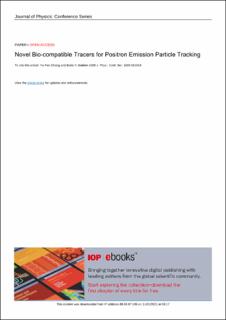Novel Bio-compatible Tracers for Positron Emission Particle Tracking
Peer reviewed, Journal article
Published version

Åpne
Permanent lenke
https://hdl.handle.net/11250/2724161Utgivelsesdato
2020Metadata
Vis full innførselSamlinger
- Import fra CRIStin [3604]
- Institutt for maskin- og marinfag [365]
Originalversjon
Chang, Y.-F., & Balakin, B. V. (2020). Novel bio-compatible tracers for positron emission particle tracking. Journal of Physics: Conference Series, 1689(1) 10.1088/1742-6596/1689/1/012019Sammendrag
To study the flow of objects in opaque flow processes, the PEPT (positron emission particle tracking) technique may be utilized. The PEPT technique is based on the same principle of positron emission tomography (PET). Both techniques detect the characteristic back-to-back gamma pairs caused by positron-electron annihilation. PEPT allows tracking of β+ - activated objects (tracers) with high spatial (microns) and temporal resolutions (milliseconds). This makes the technique promising in a number of medical applications that require observation of fast transient phenomena e.g. heart and brain hemodynamics, the aerodynamics of respiratory tract etc. However, a majority of PEPT-tracers used nowadays are tailored for industrial applications and are based on solid particles of a micrometric size, which are hardly suitable for in-vivo tests. In this contribution, we propose new bio-compatible tracers. The tracers are based on frozen radioactive solutions rather than activated solids. We produced a number of millimetre-sized ice tracers dispersing the droplets of radioactive solution in oil at negative temperatures. In this preliminary study, we demonstrate how the tracers behave in a settling column and in an agitated vessel. The PEPT-tracks are presented together with a supplementary numerical analysis that was conducted in order to estimate the freezing time of the droplets.
